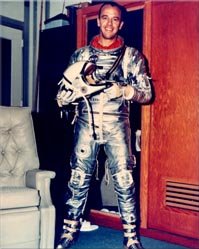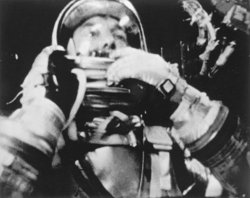Alan Shepard
|
|
Alan Bartlett Shepard, Jr. (November 18, 1923 – July 21, 1998) (Rear Admiral, USN, Ret.) was the first U.S. astronaut in space, though his first flight was only sub-orbital.

| |
| Astronaut Profile | |
| Selection date: | 1959 |
| Retirement date: | 1974 |
| Space Duration: | 9:00:57 |
| Missions | |
| Mercury 3, Apollo 14 | |
He attended the East Derry primary and secondary schools in his birthplace of Derry, New Hampshire; received a Bachelor of Science degree from the United States Naval Academy at Annapolis in 1944, an Honorary Master of Arts degree from Dartmouth College in 1962, and Honorary Doctorate of Science from Miami University (Oxford, Ohio) in 1971, and an Honorary Doctorate of Humanities from Franklin Pierce College in 1972. Graduated United States Naval Test Pilot School in 1951; Naval War College, Newport, Rhode Island in 1957.
His religious background was in Christian Science.
| Contents |
Naval Career
Shepard began his naval career after graduation from Annapolis on the destroyer Cogswell, deployed in the Pacific Ocean during World War II. He subsequently entered flight training at Corpus Christi, Texas and Pensacola, Florida, and received his wings in 1947. His next assignment was with Fighter Squadron 42 at Norfolk, Virginia and Jacksonville, Florida. He served several tours aboard aircraft carriers in the Mediterranean while with this squadron.
In 1950, he attended the United States Navy Test Pilot School at Patuxent River, Maryland. After graduation, he participated in flight test work which included high-altitude tests to obtain data on light at different altitudes and on a variety of air masses over the American continent; and test and development experiments of the Navy's in-flight refueling system, carrier suitability trails of the F2H-3 Banshee, and Navy trials of the first angled carrier deck. He was subsequently assigned to Fighter Squadron 193 at Moffett Field, California, a night fighter unit flying Banshee jets. As operations officer of this squadron, he made two tours to the Western pacific on board the carrier USS Oriskany.
He returned to Patuxent for a second tour of duty and engaged in flight testing the F3H Demon, F8U Crusader, F4D Skyray, and F11F Tigercat. He was also project test pilot on the F5D Skylancer, and his last five months at Patuxent were spent as an instructor in the Test Pilot School. He later attended the Naval War College at Newport, Rhode Island, and upon graduating in 1957 was subsequently assigned to the staff of the Commander-in-Chief, Atlantic Fleet, as aircraft readiness officer.
He logged more than 8,000 hours flying time—3,700 hours in jet aircraft.
Astronaut Career
Shepard was one of the Mercury astronauts named by NASA in April 1959 to Project Mercury, and he holds the distinction of being the first American to journey into space, as well as the only Mercury astronaut to walk on the Moon. On May 5, 1961, in the Freedom 7 spacecraft, he was launched by a Redstone rocket on a ballistic trajectory suborbital flight—a flight which carried him to an altitude of 116 statute miles and to a landing point 302 statute miles down the Atlantic Missile Range. He was scheduled to pilot the Mercury-Atlas 10 Freedom 7-II, three day extended duration mission in October 1963. The MA-10 mission was cancelled on June 13, 1963.
After the Mercury-Atlas 10 mission was cancelled in June 1963, Shepard was designated as the command pilot of the first manned Gemini mission. Thomas Stafford was picked as his co-pilot. But in early 1964, Shepard was diagnosed with Meniere's disease, a condition in which fluid pressure builds up in the inner ear. This syndrome causes the semicircular canals and motion detectors to become extremely sensitive, resulting in disorientation, dizziness, and nausea. This condition caused him to be removed from flight status for most of the 1960's (Virgil Grissom and John Young were assigned to Gemini 3 instead).
Also in 1963, he was designated Chief of the Astronaut Office with responsibility for monitoring the coordination, scheduling, and control of all activities involving NASA astronauts. This included monitoring the development and implementation of effective training programs to assure the flight readiness of available pilot/non-pilot personnel for assignment to crew positions on manned space flights; furnishing pilot evaluations applicable to the design, construction, and operations of spacecraft systems and related equipment; and providing qualitative scientific and engineering observations to facilitate overall mission planning, formulation of feasible operational procedures, and selection and conduct of specific experiments for each flight.
He was restored to full flight status in May 1969, following corrective surgery (using a newly developed method) for Meniere's disease. He was originally assigned to command Apollo 13, but as it was felt he needed more time to train, he and his crewmates (lunar module pilot Edgar Mitchell and command module pilot Stuart Roosa) swapped missions with the then crew of Apollo 14 (James Lovell, Ken Mattingly (who was himself replaced by Jack Swigert shortly before the mission), and Fred Haise).
At age 47, and the oldest astronaut in the program, Shepard made his second space flight as commander of Apollo 14, January 31–February 9, 1971, man's third lunar landing mission. Maneuvering their lunar module, "Antares," to a landing in the hilly upland Fra Mauro formation on the Moon, Shepard and Mitchell subsequently deployed and activated various scientific instruments and experiments and collected almost 100 pounds (45 kg) of lunar samples for return to earth. Other Apollo 14 achievements included: first use of Mobile Equipment Transporter (MET); largest payload placed in lunar orbit; longest distance traversed on the lunar surface; largest payload returned from the lunar surface; longest lunar surface stay time (33 hours); longest lunar surface EVA (9 hours and 17 minutes); first use of shortened lunar orbit rendezvous techniques; first use of color TV with new vidicon tube on lunar surface; and first extensive orbital science period conducted during CSM solo operations.
Awards and Honors
During his life he was awarded the Congressional Space Medal of Honor; two NASA Distinguished Service Medals, the NASA Exceptional Achievement Medal, Naval Astronaut Wings, the Navy Distinguished Service Medal, and the Distinguished Flying Cross; recipient of the Langley Award (highest award of the Smithsonian Institution) on May 5, 1964, the Lambert Trophy, the Iven C. Kincheloe Award, the Cabot Award, the Collier Trophy, the City of New York Gold Medal (1971), Achievement Award for 1971.
Shepard was appointed by the President in July 1971 as a delegate to the 26th United Nations General Assembly and served through the entire assembly which lasted from September to December 1971.
Shepard is also remembered for being the only person to play golf on the Moon (using a converted soil sampler as his club).
Last Years
Shepard died of leukemia near his home in Pebble Beach, California at age 74. His wife of 53 years, the former Louise Brewer, died five weeks afterward.
External link
- NASA-Biography (http://www.jsc.nasa.gov/Bios/htmlbios/shepard-alan.html)de:Alan Shepard
nl:Alan Shepard ja:アラン・シェパード fi:Alan Shepard it:Alan Shepard pl:Alan Shepard ru:Алан Шепард sv:Alan Shepard

